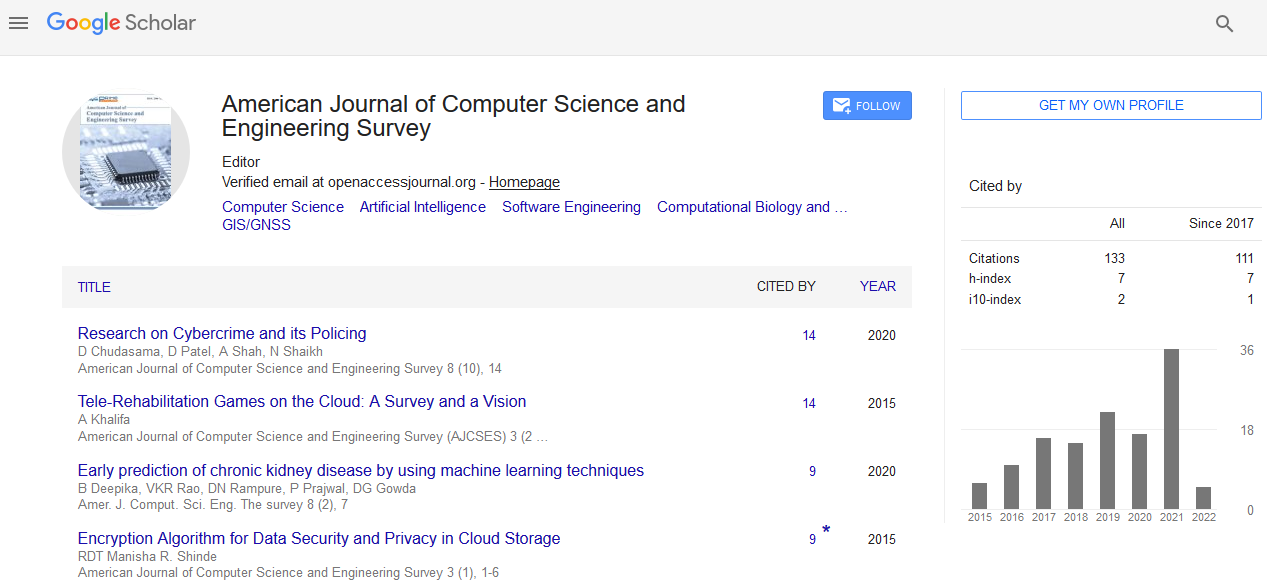Opinion - (2022) Volume 10, Issue 4
Improved Computer Algorithm in Plant Cultivation Robots for Better Output
Hailong Sun*
Department of Computer Science, Northeast Forestry University, China
*Correspondence:
Hailong Sun,
Department of Computer Science, Northeast Forestry University,
China,
Tel: 8541279630,
Email:
Received: 29-Jun-2022, Manuscript No. IPACSES-22-14444;
Editor assigned: 01-Jul-2022, Pre QC No. IPACSES-22-14444 (PQ);
Reviewed: 15-Jul-2022, QC No. IPACSES-22-14444;
Revised: 20-Jul-2022, Manuscript No. IPACSES-22-14444 (R);
Published:
27-Jul-2022, DOI: 10.36846/2349-7238-10.4.17
Introduction
Examination into canny plant developing robots has extraordinary
potential in the present wise plant developing. The robot
proposed in this distribution has a set number of developed
plants, a generally fixed area, badly designed development,
and unyielding activity, and so on, which is not quite the same
as regular smart robots for developing plants. It can tackle a
portion of the deficiencies of regular plant developing gear. The
robot can naturally find plants set in the room, plan a course,
and move toward the plants to develop them. This work basically
investigates two issues. The primary issue is tracking
down plants in an obscure climate, and the subsequent issue
is way enhancement given the supposition of tracking down
plants. Visual pummels are a well-known technique for finding
and remaking insightful plant rearing robots. Be that as it may,
involving Visual Ram for office search and guide drawing unavoidably
presents mistakes after some time and corrupts map
drawing execution.
Description
We propose better approaches to find focuses in new conditions
perpetually. Besides, the strategy depends on lidar and
profundity cameras and proposes a key marker calculation.
Whenever you have decided your current circumstance, recognize
your frameworks. There are numerous proficient and
strong calculations in the field of picture acknowledgment,
like R-CNN, Quicker RCNN, SSD and Yolo V3. We thoroughly
thought about precision, time and asset utilization, lastly involved
the Yolo V3 calculation for plant ID. In the event that the
not entirely set in stone to be a plant, the distance between the
plant and the robot can be estimated with a profundity camera
and the particular place of the plant can be gotten. This strategy
is less vulnerable to outer impacts, has higher exactness,
and has specific pragmatic importance and application esteem.
As to streamlining, we tracked down the accompanying issues
with the A* calculation during multi-objective programming.
Low pursuit effectiveness. In genuine use, it is excessively near
hindrances and it is not difficult to impact. Way isn’t the most
ideal arrangement assuming that the distance is excessively
huge? The bend isn’t sufficiently smooth and not exactly ideal
at corners. To take care of the above issues, we propose a canny
plant rearing robot in view of: The robot framework has the
accompanying advantages and the robot framework consolidate
subterranean insect state calculation and strengthening
calculation to track down the briefest way in multi-objective
planning; The robot framework will set up various hunt bearings
as per various headings of the objective point, and work
on the pursuit from 8 headings to 5 headings to further develop
the pursuit efficiency; The robot framework adds hostile
to crash rules to forestall impacts; The robot framework
streamlines the assessment capability, making the assessment
capability focus harder on the distance between the robot and
the objective point at a significant distance, and the distance
between the robot and the objective point is equivalent to previously;
The robot framework further develops the Floyd algorithm
to enhance the two-way perfection of the way and work
on the perfection of the way.
Conclusion
As displayed in, the exploratory stage utilized in this paper is a
robot in light of the Jetson nano. The robot comprises of four
modules, plant development module, visual acknowledgment
module, map recreation module and course arranging module.
In this article, we for the most part present our course arranging
module and guide drawing module in light of key marker
calculation. There is an outline of the framework as displayed.
This archive centers on the course arranging module and the
guide recreation module. In it, the course arranging module
utilizes a superior A* calculation.
Citation: Sun H (2022) Improved Computer Algorithm in Plant Cultivation Robots for Better Output. J Aquat Pollut Toxicol. 10:17.
Copyright: © 2022 Sun H. This is an open-access article distributed under the terms of the Creative Commons Attribution License,
which permits unrestricted use, distribution, and reproduction in any medium, provided the original author and source are
credited.

